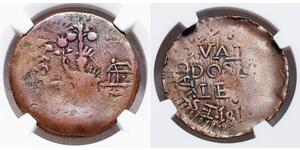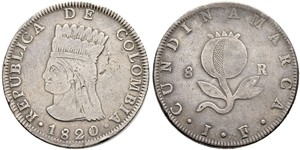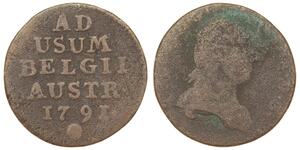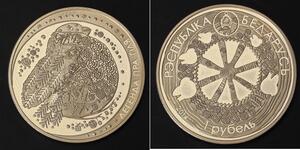2 Real Colombia Copper
1813, Colombia, Cartagena, Siege Coinage. Copper 2 Reales Coin
Mint Year: 1813
Mint Place: Cartagena
Reference: KM-D1 ($450 in XF40, no valuation in AU!)
Denomination: 2 Reales - Provisional Anti-Royalist Siege Coinage, issued for Pre-Republican Cartagena!
Weight: ca. 3.5gm
Material: Copper
Diameter: 27mm
Obverse: Figure (indian shouldering quiver?) left below palm, arm outstretched, holding a flower (pomegrenate?) and feeding bird (liberty?). Small palm and a building to left and right in background.
Reverse: Inscription in three lines surrounded by legend.
Legend (around): ESTADO . DE . CARTAGENA . 1813 .
Legend (in field): . VAL . DOS REA . LES
Cartagena was the first major Colombian city to declare independence from Spain, but was retaken by the Royalists in 1815.
Since the beginning of the periods of conquest and colonization, there were several rebel movements under Spanish rule, most of them were either crushed or remained too weak to change the overall situation. The last one which sought outright independence from Spain sprang up around 1810, following the independence of St. Domingue (present-day Haiti) in 1804, which provided a non-negligible degree of support to the eventual leaders of this rebellion: Simón Bolívar and Francisco de Paula Santander.
A movement initiated by Antonio Nariño, who opposed Spanish centralism and led the opposition against the viceroyalty, led to the independence of Cartagena in November 1811, and the formation of two independent governments which fought a civil war – a period known as La Patria Boba. The following year Nariño proclaimed the United Provinces of New Granada, headed by Camilo Torres Tenorio. Despite the successes of the rebellion, the emergence of two distinct ideological currents among the liberators (federalism and centralism) gave rise to an internal clash which contributed to the reconquest of territory by the Spanish. The viceroyalty was restored under the command of Juan de Samano, whose regime punished those who participated in the uprisings. The retribution stoked renewed rebellion, which, combined with a weakened Spain, made possible a successful rebellion led by the Venezuelan-born Simón Bolívar, who finally proclaimed independence in 1819. The pro-Spanish resistance was finally defeated in 1822 in the present territory of Colombia and in 1823 in Venezuela.
(3205 X 1545 pixels, file size: ~870K)
Posted by: anonymous 2024-03-12
Untitled Document 1813, Colombia, Cartagena, Siege Coinage. Copper 2 Reales Coin. NGC AU-55 BN! Mint Year: 1813 Mint Place: Cartagena Condition: Certified and graded by NGC as AU-55! Reference: KM-D1 ($450 in XF40, no valuation in AU!) Denomination: 2 Reales - Provisional ...
1 Liard Austrian Netherlands (1713-1795) Copper
group has 7 coins / 7 prices
⇑
One of them is









-300-150-NgSsHgTyCiIAAAGW1HxyjNgw.jpg)







